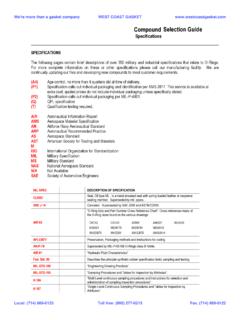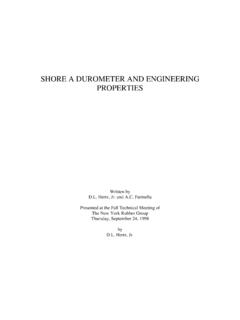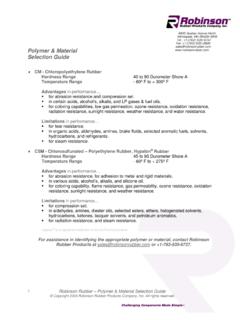Transcription of Hardness of Rubber Rollers - Imperial Rubber Products
1 Page 1 Hardness of Rubber Rollers April 2012 Overview After receiving considerable positive feedback on my last article sharing a conversation with a customer, we decided to share another. This article summarizes a series of exchanges recently with a customer about something that might appear rather mundane, but turned out to be very enlightening for him, and we hope for others as well. The topic of our conversation was Rubber Hardness and how to determine the Hardness of Rubber Rollers . This includes a discussion of ASTM guidelines, tools for measuring Rubber Hardness , and several reasons why this topic is so critical to process control. We also discussed how Imperial Rubber Products adheres to tighter standards than the industry norms. Page 2 A Conversation with a Customer Takes a Turn A customer recently returned my call notifying him that a roll we were producing for his company was going to take a couple days more to deliver than we had initially discussed.
2 He naturally inquired as to the reason for the change in plans and I explained that the Hardness of the roll didn t meet our specifications. He wanted more information about this and asked, What is the standard for the industry? My reply was that, the industry standard for Hardness of Rubber is plus or minus 5 points, so there s a 10 point range. And he said, Well, the magnitude of the variation allowed by that specification may be affecting my process; I could drive a truck through something that wide. So I explained that, Yes, you could. A 10 point range can introduce tremendous variation in the way your system, which is trying to apply a coating to a plastic, is going to react, in response to a force applied. And so what originally started off as a conversation about why the roll would take a bit longer to deliver, all of a sudden turned into a discussion of Rubber Hardness and its impact on process control.
3 Wow, I had no idea. ASTM Guidelines for Testing Hardness of Rubber Rollers So we discussed further what the industry norms allow. I explained that the source of the standard is ASTM D2240, which allows plus or minus 5 points around a target Hardness specification, meaning a 10 point range of Hardness is acceptable. This test method is based on the penetration of a specific type of indentor when forced into the material under specified conditions. The indentation Hardness is inversely related to the penetration and is dependent on the elastic modulus and viscoelastic behavior of the material. [Source: ] And he said, Well if that s not your standard at Imperial Rubber Products , what do you do? Tighter Tolerances Than Industry Norms I explained that our approach is measured on the same scale, but that our standard allows only half as much variation as the industry allows.
4 The result is that on a Hardness scale ranging, for example, from zero to 60, we allow for +3 to -2 points, a total range of 5 points; and if the Hardness being measured is above 60, we use the reverse. In that case, our acceptance criteria are -3 to +2 points. That s still a range of 5 points on the Hardness scale. At Imperial , we control that variance more tightly than the industry norms, so that the response in your system can be more controlled. Page 3 Our customer asked what we have to do in order to achieve those tighter standards. My reply was that, when we choose a supplier of Rubber , that tighter standard is part of the qualification process, and if they re unwilling to accept that, then we re not going to do business with them. That s because that narrower range is our governing specification for our supply chain, and that s the same standard we hold ourselves to internally.
5 So the people in our supply chain make up a closed loop system. He reiterated that he wasn t aware that we held the durometer specification so tight. And he wanted to check the durometer of the rolls in his shop. So he did that and called me back a little later and said, You know, I went outside and I checked the rolls we have in house. The specification we have from the OEM is that they re supposed to be at 60 durometer . But based on what you re telling me, the rolls we get could be as hard as 62. But the roller actually measured 64, so it s outside of that range. How could that be? durometer Measures the Hardness of a Rubber roller Before proceeding further with this story, it s important to make sure that we are clear about a few fundamentals. Let s start with the basic terminology. First, let s be clear that durometer is the international standard for measuring the Hardness of Rubber .
6 The Hardness of a material is determined as its resistance to surface penetration. The term durometer is often used to refer to the measurement, as well as to the instrument itself. [Source: ] Correct Way to Measure the Hardness of Rubber Rollers A second fundamental concept to ensure we have clear is that there is a right way and a wrong way to use a durometer to measure Hardness . In the correct way, the base of the durometer is parallel with the axis of the roller . The wrong way would be having the base of the durometer perpendicular to the axis of the roller . If you were working with a completely flat surface, that technique would not be critical. But with Rollers we re dealing with a curved surface. And such an object has a radius and a center, and these are important considerations. If you were to turn the durometer 90 degrees from the axis of the roller , it would be rolling onto the durometer base, which provides inaccurate reference data when the durometer makes its measurement.
7 To avoid this, the base of the durometer , or the base of the instrument, has to be in line with (or following the same line as, or parallel to) the axis of the roll. As such, an incorrect way to take a measurement of Hardness would be if the base of the durometer , or the base of the tool, was actually not parallel to the axis of the roll or the shaft that s holding the roll. Page 4 So I sent him photographs that showed different ways of holding a durometer and using it to measure the Hardness of a Rubber roll. Held incorrectly one way, the durometer will give a false reading that s too and held incorrectly another way, the durometer will give a false reading that s too low. Another photo I sent him showed the correct way to measure Hardness of a Rubber roll with a durometer . Examples of How to Hold a durometer to Measure Hardness of a Rubber roller INCORRECTLY How to Hold a durometer to Measure Hardness of a Rubber roller CORRECTLY In the photo above, the durometer is correctly placed parallel to the axis of the roller being measured Page 5 Methods for Measuring the Hardness of a Rubber roller Now that we re clear on those key concepts, let s get back to my story.
8 You ll recall that the customer asked how he could check the Hardness of a roll and get a different reading than we did at our shop. Here I replied, Well, therein lies a different conversation, where the topics are: What kind of durometer are you measuring? What is the technique you re using? and Are you aware of what ASTM says the range should be for different people using different durometers on different types of materials? Taken together, these factors present quite a few possible sources of variation in the measurement of Hardness of a Rubber roller . So I said to him, If you d like, I could come over with the calibrated durometer that we use, and we could check that together. What we both realized was that his company is not as accustomed to doing durometer checks as we are at Imperial Rubber Products . Thickness of the Rubber Measured There s still another factor that can impact results.
9 We ve had discussions where a customer says, I ve measured the Hardness on the roll, and it s reading much harder than it should. And then we say, well your specification on the depth of the Rubber you want applied to the roll impacts the measurement of Hardness . Sometimes a customer s application calls for only one-eighth of an inch (1/8 ) of Rubber , and the ASTM specification says that if you re going to make an accurate reading with your durometer , the Rubber must be at least one-quarter of an inch (1/4 ) deep. That s because, under one-quarter of an inch, the measurement begins to reflect the Hardness of the subspace to which the Rubber is bonded. And the thinner the roll covering, the more the underlying substrate reflects in the measurement of Hardness . So seeing a measurement above the target specification can be the results of the combination of the Hardness of the Rubber and the Hardness of whatever it s bonded to (the steel or aluminum or carbon fiber material of which the roller is constructed).
10 Page 6 Importance of the Hardness of a Rubber roller While this article has already considered several important aspects of measuring Hardness , it s probably worthwhile to step back and consider why Rubber Hardness is more important than some people may think it is. Certainly it s obvious that Rubber Hardness is a key characteristic of a Rubber roll. But why is it more important to pay attention to it than some people may think? The answer can be traced to the reason for having the roller in a production process in the first place. If the function of a roller is to pull or steer something, then the Hardness controls its traction power. To avoid a detailed discussion of coefficient of friction let s just say that as the Rubber becomes harder, its traction is reduced. This is much like the Rubber tires on a race car. If you re in a dragster, then at the start of the race, you really want the car to stick to the track.







